Expert’s Rating
Pros
- Superb cover screen
- Great internal display
- Excellent main rear camera
- Top-tier software experience
- Seven years of updates
Cons
- Battery life could be better
- Painfully slow 25W charging
- Still no telephoto camera
Our Verdict
The Galaxy Z Flip 7 is the flip phone I’ve been waiting for from Samsung, with the big cover display, superior cameras and long software support making it a better buy than the Razr 60 Ultra for most people. However, familiar shortcomings prevent it from being an easy recommendation.
Price When Reviewed
This value will show the geolocated pricing text for product undefined
Best Pricing Today
Best Prices Today: Samsung Galaxy Z Flip 7

$1,099.99
Flip phones have been around for more than half a decade, but one brand continues to dominate, at least in the UK and US: Samsung.
The Korean giant’s Galaxy Z Flip line has led the way for a while, but in 2024, Motorola’s Razr 50 Ultra ended up being Tech Advisor’s best flip phone of the year, with that big cover display playing a major role.
Samsung has responded with a cover screen upgrade of its own on the Galaxy Z Flip 7, delivering arguably the biggest generational change we’ve seen since its 2020 debut.
Is it enough for Samsung to regain its crown as the flip phone maker to beat? After testing the Razr 60 Ultra earlier this year, I spent a week using the Galaxy Z Flip 7 to find out, and the results weren’t what I was expecting.
Design & Build
- Bigger cover and internal displays
- Slim, lightweight build with tough hinge
- IP48 water and dust resistance
The Galaxy Z Flip 7 has a big design upgrade, and I’m here for it.
While the general form factor is the same – a small cover screen that opens to reveal a regular phone screen – the dimensions have changed significantly.
The big news is that the cover screen (or ‘FlexWindow’, as Samsung officially calls it) has increased hugely, from 3.4 inches on the Z Flip 6 to 4.1 inches here. It extends almost all the way to the edge of the device, with a slim bezel making it look a lot more modern. Finally, Samsung has matched the bar set by Motorola in this area.
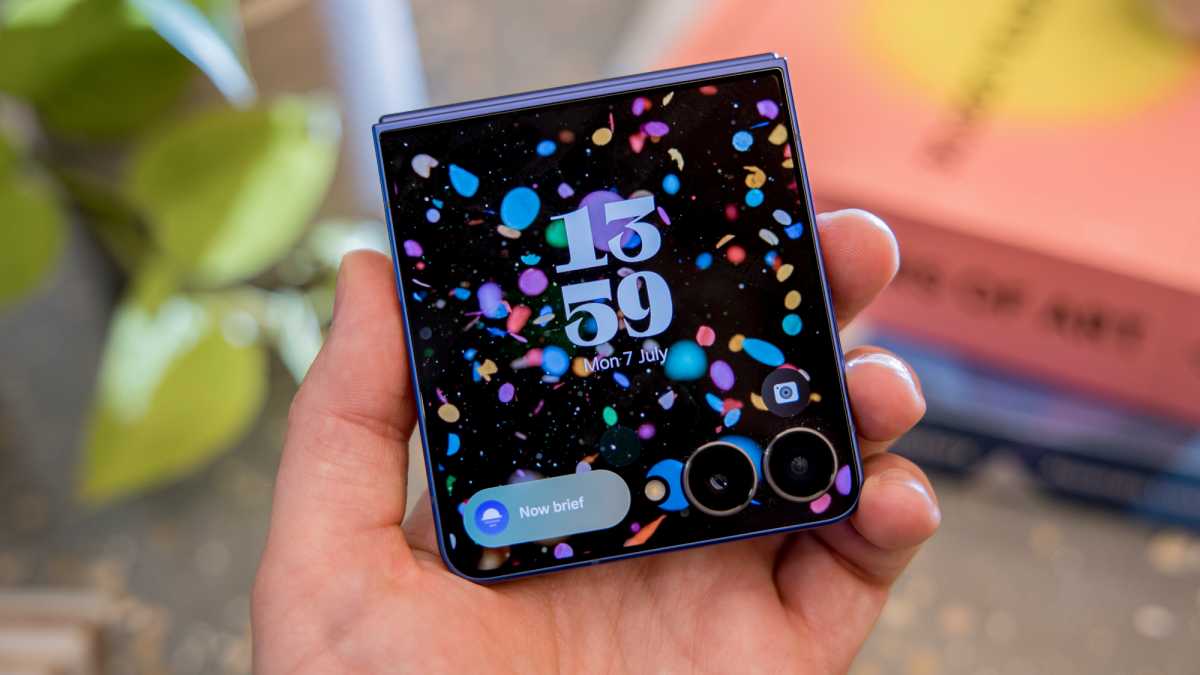
Dominik Tomaszewski / Foundry
To make room for it, Samsung has also increased the internal display from 6.7- to 6.9 inches. It’s a subtle change, but one I noticed straight away, as it makes the phone significantly taller (75.2mm instead of 71.9mm). Initially, I found the phone a little uncomfortable to use (one-handed usage is pretty much out of the question), but it didn’t take too long to adjust.
And when that internal display is turned on, the crease is totally invisible. The only times you’ll notice it is if you happen to rest your finger on it, which was pretty rare in my case.
The Galaxy Z Flip 7 has a big design upgrade, and I’m here for it
I also really appreciate how robust the aluminium hinge feels. I haven’t exactly been careful when opening and closing it, aiming to simulate the effect longer-term usage, but it didn’t show any signs of weakness whatsoever. I’d be confident in it surviving many years of open-close cycles.
Unlike early Galaxy Z Flip models, the Flip 7 folds in half completely flat, yet remains a relatively svelte 13.7mm. Combined with a lightweight 188g build, these compact dimensions meant I often forgot the phone was even in my pocket. It’s one of very few handsets that’s likely to fit in women’s trousers, though I can’t verify that.
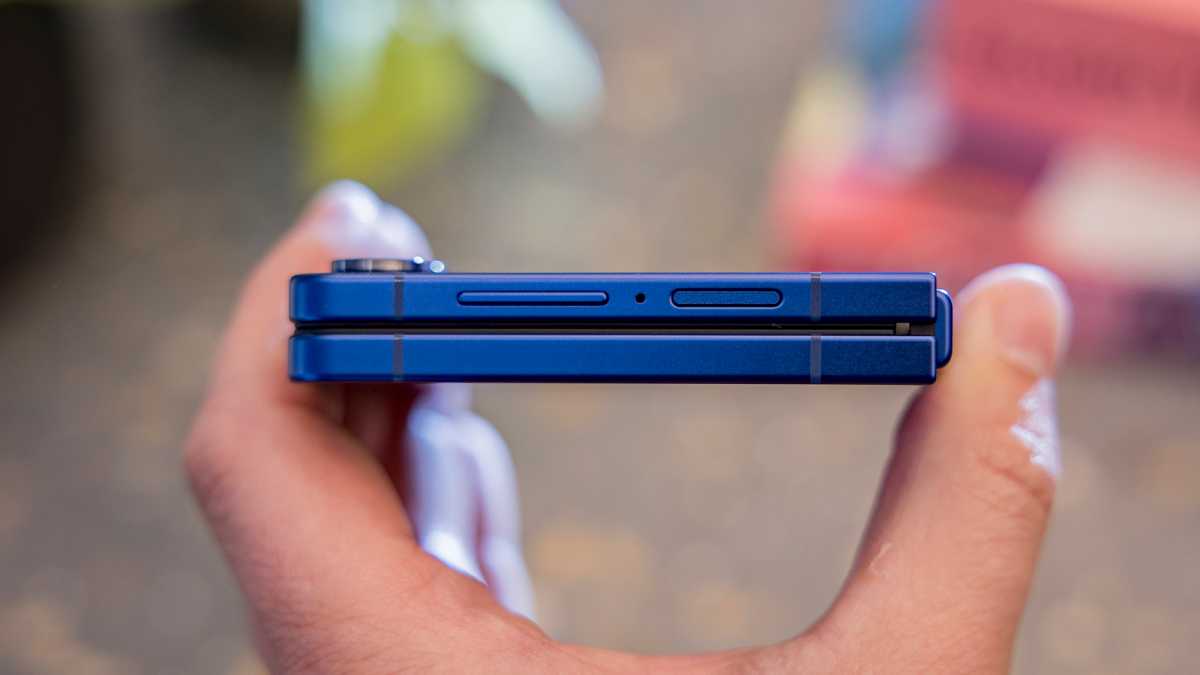
Dominik Tomaszewski / Foundry
Durability in general is a key strength of the Z Flip 7. The back of the device is equipped with Corning’s tough Gorilla Glass Victus 2, which is specifically designed to protect it from drops onto rough surfaces.
The device also retains an IP48 rating, meaning it’s safe from submersion in up to 1.5m of freshwater though it remains vulnerable to particles smaller than 1mm (such as sand). Like all current flip phones, I’d be extra careful when taking it to the beach.
The Z Flip 7 is available in four colours: ‘Blue Shadow’, ‘Jetblack’, ‘Coralred’ and ‘Mint’, with the latter exclusive to the Samsung website. I tested the former, a deep navy hue that shimmers in the light and looks really classy.
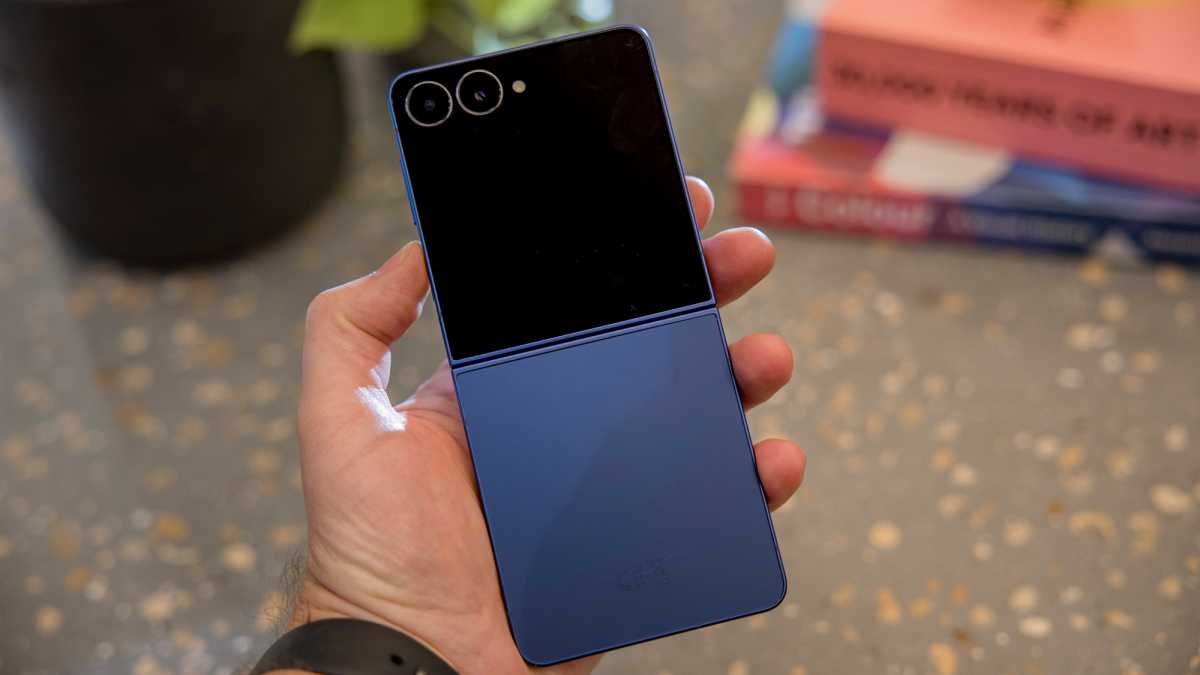
Dominik Tomaszewski / Foundry
Unlike non-folding phones, the colour you go for is crucial, as I wouldn’t recommend applying a case. Despite being made from glass, the matt coating on the back of the device makes it impressively grippy and generally resistant to fingerprint smudges.
Talking of fingerprints, the sensor for unlocking the device is built into the power button on the right side. Samsung has cleverly positioned it to be in a natural position when both folded and unfolded, and it’s consistently fast and reliable. I don’t miss an under-display scanner at all.
Screen & Speakers
- 4-inch, 120Hz AMOLED cover screen
- 6.9-inch, 120Hz AMOLED internal display
- Stereo speakers
As mentioned above, both of the Z Flip 7’s displays are bigger than their Z Flip 6 equivalents. But what are they actually like to use?
In short, very good. On the 4-inch cover screen, Samsung finally has an external display that’s fit for its flagship flip. And the new 6.9-inch internal display is one of the best you’ll find on any phone – folding or not.
Let’s start with the cover screen, the single biggest upgrade this time around. Samsung has improved almost everything about this display, and it’s really paid off.
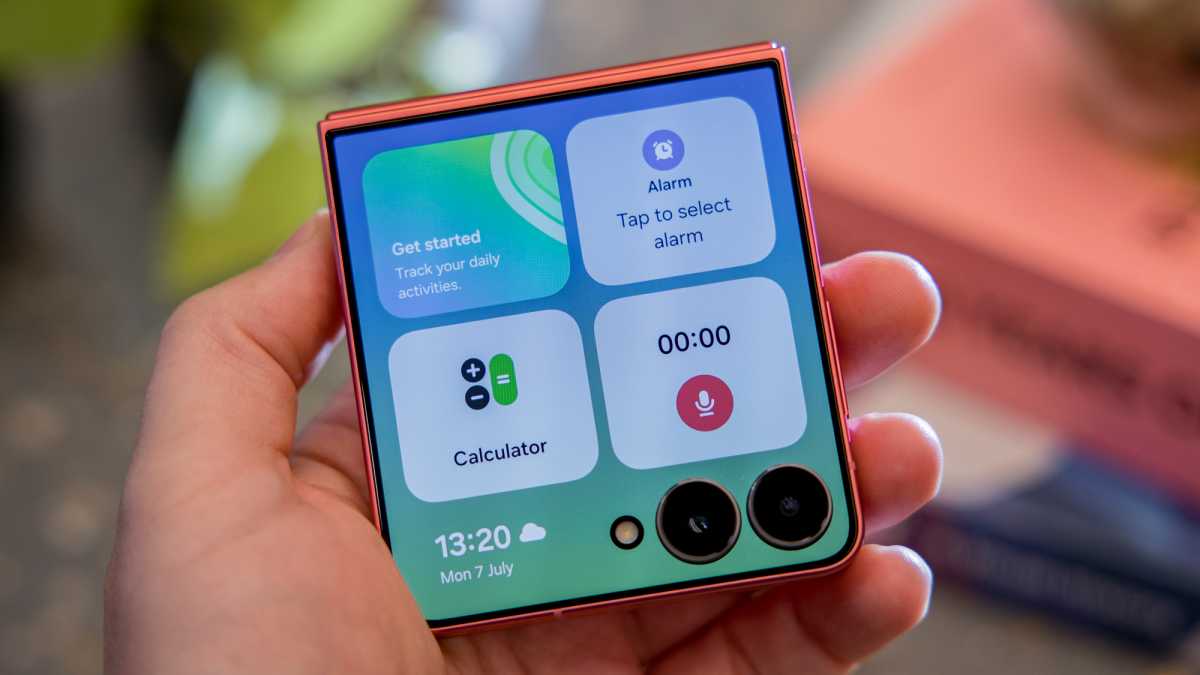
Dominik Tomaszewski / Foundry
The resolution has increased to 948 x 1048, resulting in crisp visuals and excellent clarity. A doubling of the refresh rate to 120Hz means navigating the display is smooth and fluid, while a peak brightness of 2600 nits ensures outdoor visibility is excellent.
And, of course, this is still an AMOLED panel, meaning you get those vivid colours and deep blacks that we’ve come to associate with Samsung phones.
There’s no doubting that the Z Flip 7 has a pair of excellent displays
The display now stretches around the camera lenses, which can prevent you from accessing some functionality, particularly on third-party apps which aren’t optimised.
To remedy this, you’ll find a small on-screen button at the bottom of the display that allows you to cycle between three different aspect ratios, including one that looks like a regular phone. It’s a simple yet very effective solution.
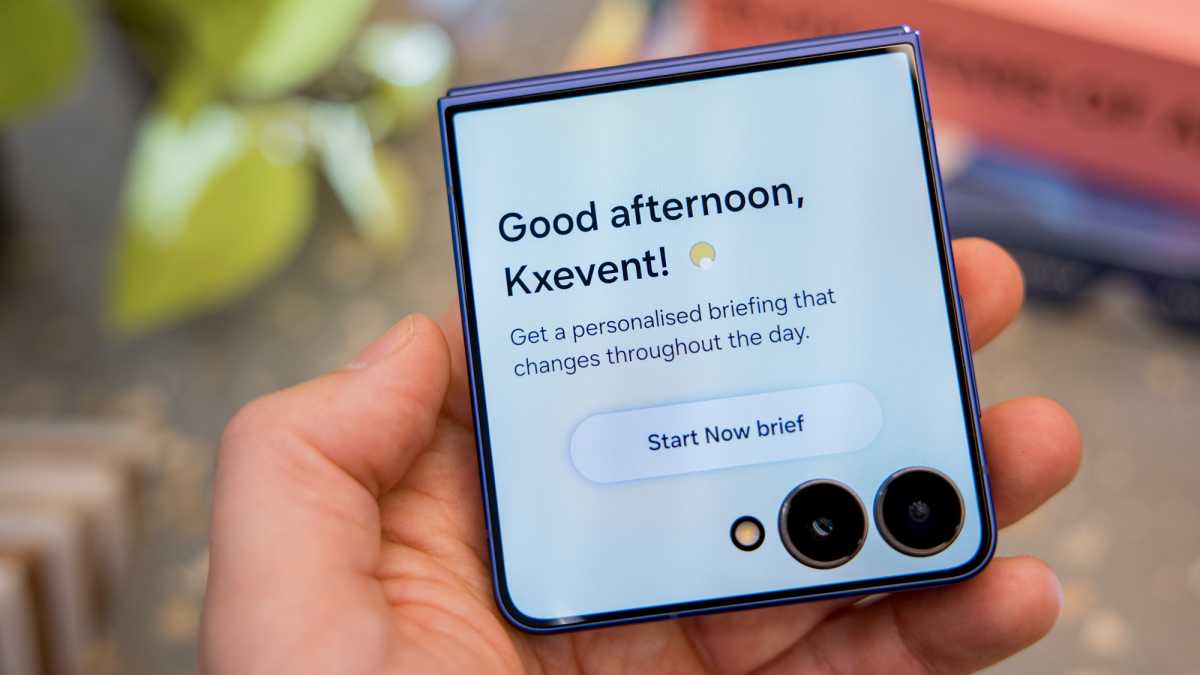
Dominik Tomaszewski / Foundry
Speaking of regular phones, the internal display looks just like any other Samsung flagship, which is great news. At 6.9 inches, it’s on the larger side, but not unheard of for a modern handset.
And I have no complaints when it comes to quality. The Full HD+ (1080 x 2520) resolution is fractionally lower than last year’s Z Flip 6, but it’s almost impossible to tell the difference. In other words, it offers more than enough detail for anyone to be satisfied.
As an AMOLED, it’s great for any visual content, from gaming and social media to TV shows and movies. And the 783 nits I recorded in ‘Extra brightness mode’ (426 with it turned off) means you can clearly see the screen in almost any environment.
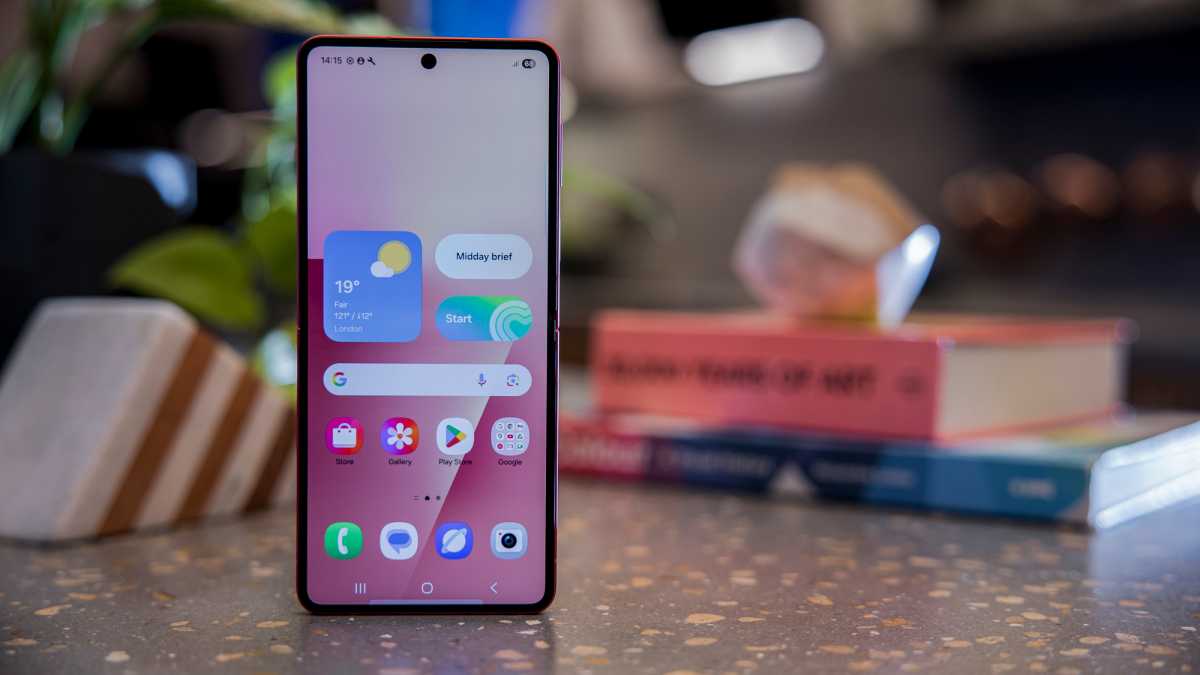
Dominik Tomaszewski / Foundry
The 120Hz refresh rate remains (the Razr 60 Ultra’s 165Hz isn’t widely supported), but it’s frustrating to be limited to either a fixed 60Hz ‘Standard’, or ‘Adaptive’, which alternates between the two. I’d like to see Samsung introduce LTPO, which would allow the refresh rate to drop as low as 1Hz when not required, plus the option to stay at 120Hz all the time.
However, overall, there’s no doubting that the Z Flip 7 has a pair of excellent displays.
In terms of audio, the Z Flip 7 has the stereo speaker setup we’ve come to expect on modern phones – one downward-firing, one earpiece. Sound quality is fine, getting decently loud without any audible distortion, but it’s really nothing special. During longer listening sessions, you really notice the slightly tinny sound and lack of bass.
As usual, if you’re serious about sound quality, I’d highly recommend connecting headphones or a Bluetooth speaker.
Specs & Performance
- Samsung Exynos 2500 chipset
- 12GB of RAM
- 256- or 512GB of non-expandable storage
Samsung has switched things up with the Galaxy Z Flip chipset this time around. After years of Qualcomm silicon, the Z Flip 7 is powered by the company’s own Exynos line instead – specifically, the Exynos 2500. Here, it’s paired with 12GB of RAM across both models.
As past benchmarks have shown, this isn’t as powerful as the Snapdragon 8 Elite, Qualcomm’s latest and greatest. So, what does that mean for Z Flip 7’s performance?
Most of the time, very little. During a full week of regular usage, I didn’t run into a single performance issue. The Z Flip 7 was consistently fast and reliable, even with over 100 Chrome tabs open (I know) and quickly switching between lots of apps.

Dominik Tomaszewski / Foundry
If your daily usage looks anything like mine, with plenty of web browsing, messages and emails, plus some photography and the occasional call, the Z Flip 7 will cope just fine. Impressively, throughout all these tasks, the device never even got warm to the touch.
As expected, demanding gaming proves to be more of a challenge. While gameplay is generally smooth, I noticed quite a few dropped frames here and there, especially on PUBG Mobile and Real Racing 3.
Call of Duty: Mobile was more consistent, but all three caused significant heat build-up, particularly around the cover screen. It also depleted battery life much more quickly than anything else I used the Z Flip 7 for.
During a full week of regular usage, I didn’t run into a single performance issue
You’re probably not buying this device for its gaming performance, and casual titles won’t be a problem. But if you’re serious about mobile gaming, go for a book-style foldable or non-folding phone instead.
I’m pleased to see Samsung increase the storage on the base model from 128- to 256GB without increasing the price. That should be enough for most people, but with no support for Micro-SD expandable storage, step up to 512GB if you’re unsure.
The Z Flip 7 supports the latest Wi-Fi 7 standard, plus Bluetooth 5.4 and NFC for the likes of contactless payments.
Samsung Galaxy Z Flip 7 benchmarks
Cameras
- 50Mp, f/1.8 main
- 12Mp, f/2.2 ultrawide
- 10Mp, f/2.2 front-facing
The Galaxy Z Flip 7’s camera hardware is identical to its predecessor. And judging from the results, there are no meaningful changes to Samsung’s software processing, either.
But, rather than repeat what I said in my Z Flip 6 review, I’ll try to describe things a bit differently. The short version is that the main lens is very good, the ultrawide sensor is decent and the front-facing camera is a bit underwhelming, but you’ll be using the rear lenses to take selfies anyway.
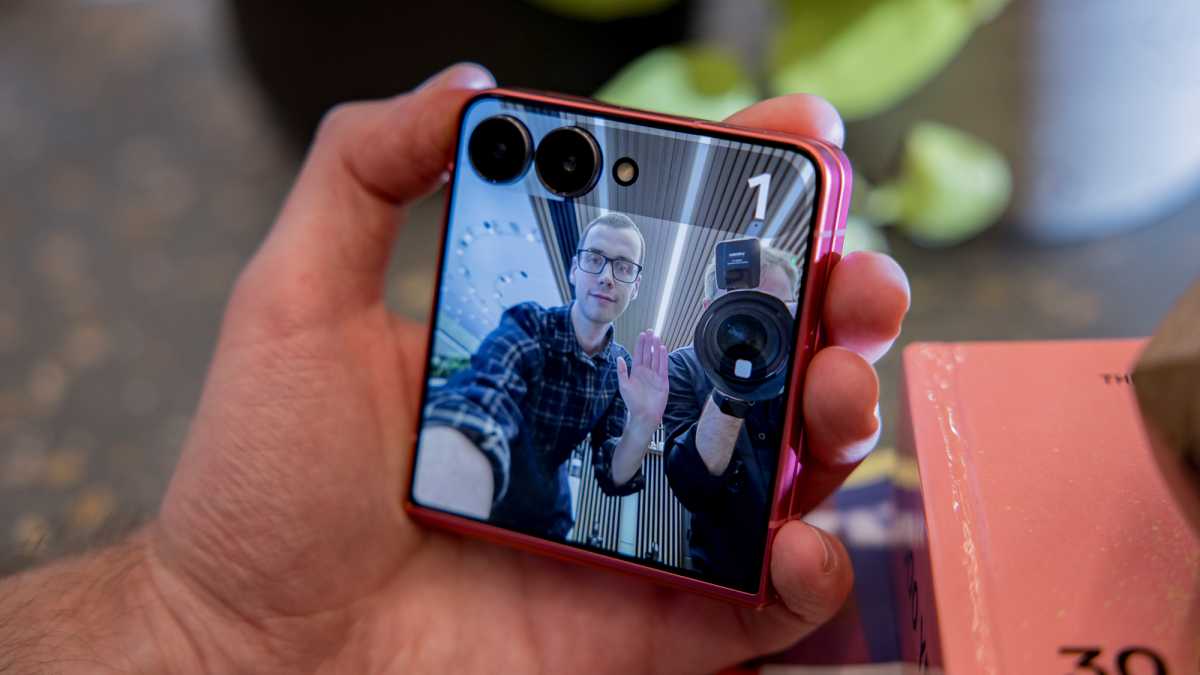
Dominik Tomaszewski / Foundry
The 50Mp main lens is a small step down compared to the very best camera phones on the market, including the 200Mp sensor on the Galaxy S25 Ultra. But it still delivers consistently excellent photos across a range of situations.
In good lighting, images are clean, crisp and brimming with detail. Samsung’s tendency for vibrant, high-contrast photos has been toned down in recent years, but there’s still a noticeable boost to colours. The results are visually appealing, albeit not true to life.
Still, the Z Flip 7 handles complex shadows and exposures very well, capturing great detail in some of the moody skies. Dynamic range is also very good, meaning a range of different brightness levels can be accurately represented.
I found the main lens to be equally adept at landscapes, street photography and complex architecture – it’s very versatile.
In good lighting, images are clean, crisp and brimming with detail
In low light, the night mode kicks in automatically, doing a good job of brightening the image without making it look artificial. However, it does introduce some noise and can struggle with any bright lighting.
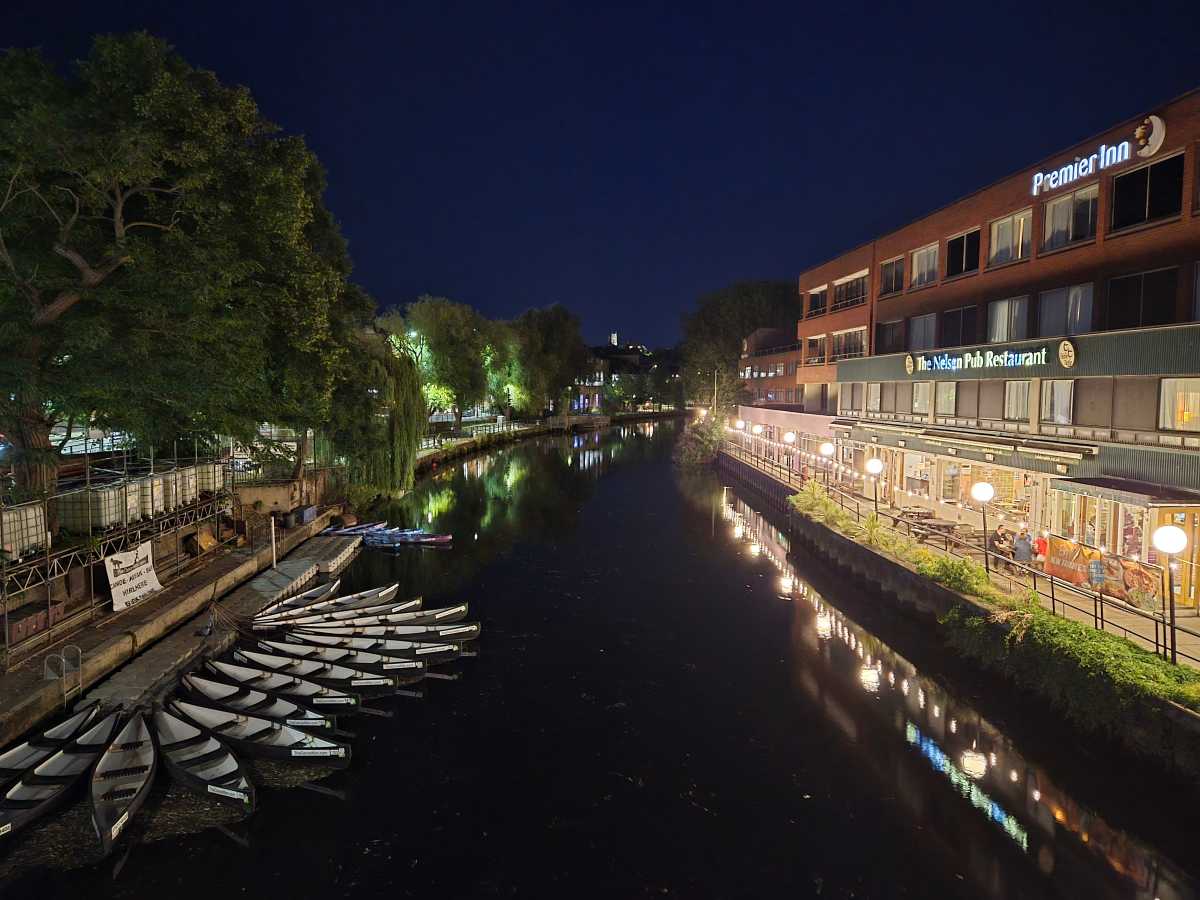
Anyron Copeman / Foundry
The 12Mp ultrawide is a capable secondary lens, offering the versatility of a 123˚ field of view without a major drop-off in quality. There’s a clear difference in detail and colour accuracy between the two, but I was still happy to use it in a variety of scenarios.
However, without a telephoto lens, you’re entirely reliant on this sensor and the Z Flip 7’s disappointing digital zoom capabilities. Anything beyond 2x quickly loses definition and colour accuracy, with Samsung limiting this to 10x feeling like an admission of these limitations.
In the past, I could just about understand the argument that a third lens would get in the way of the screen. But with the Z Flip 7 moving to a full-screen cover display, they’re obstructing it anyway. As someone who enjoys going to concerts, even a 3x optical zoom would make a massive difference.
Even if including three different lenses isn’t possible (and while I find that hard to believe, I have a theory as to why further down this review), I’d prefer Samsung to follow Motorola’s decision with the 50 Ultra to swap the inferior ultrawide lens for a telephoto, which would make a huge difference to both portrait shots and zoomed-in snaps.
Of course, a key selling point of flip phones is the ability to use the rear lenses to take selfies. I love the way the main lens accurately captures my skin tone and delivers a convincing background blur in portrait mode. Meanwhile, switching to the ultrawide makes it perfect for group selfies, and I love that you can just hold up your palm to start a countdown timer.


The actual front-facing camera is a decent 10Mp sensor that’s in line with most modern smartphones. There’s nothing necessarily wrong with it, though video calls are the only time I could see myself using it.
On the video side, the main lens can shoot in up to 4K at 30fps, though the default 1080p at 30fps will be just fine for most people. OIS (optical image stabilisation) means footage remains relatively steady, though it can look washed out and often struggles with exposure.
It’s absolutely fine for social media and home videos, but I wouldn’t recommend it for anything more serious.
Battery Life & Charging
- 4300mAh battery
- 25W wired charging
- 15W wireless, 5W reverse wireless
I complained about the Galaxy Z Flip 6 battery life quite a lot, so I’m glad to see Samsung increase the capacity from 4000mAh to 4300mAh. However, when most non-folding phones exceed 5000mAh, that’s still a little underwhelming.
Battery life has undoubtedly improved, to the extent that I usually don’t worry about it lasting to the end of a full day. However, none of my testing days involved anything more than moderate usage, so I’d be worried about it holding up on a demanding day of travelling, for example.
Battery life definitely isn’t the weakness it once was, but I wouldn’t call it a strength, either
Unfortunately, our usual PCMark battery test wouldn’t run properly on the Z Flip 7, so I can’t offer any objective comparisons. But what I can say is that after three hours of usage across a 16-hour day, the Z Flip 7’s battery went from full to 15%, which isn’t ideal.
Battery life definitely isn’t the weakness it once was, but I wouldn’t call it a strength, either.
Unfortunately, the charging situation is even worse. Samsung still hasn’t improved the measly 25W charging speeds, and it proved to be a constant source of frustration. With no charger in the box, you’ll have to supply one of your own, but I’m confident you already have one that’s plenty fast enough.
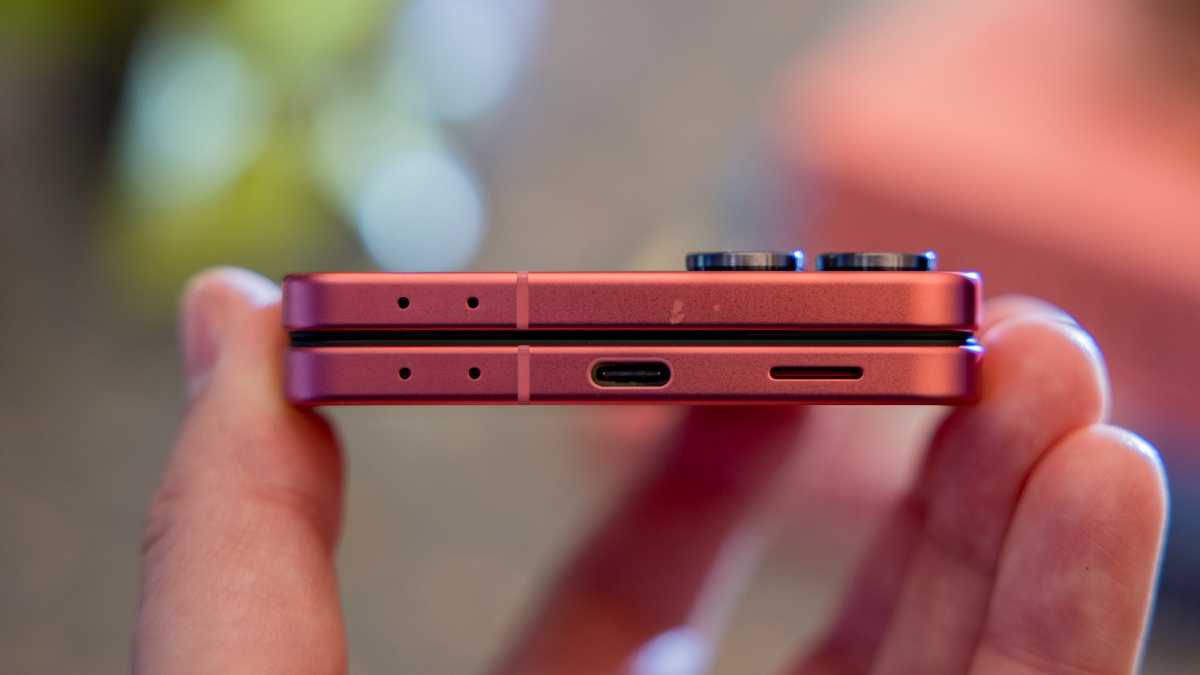
Dominik Tomaszewski / Foundry
In my testing, the Z Flip 7 went from 0-18% in 15 minutes, then 33% by the half-hour mark. At that rate, it’ll take over 90 minutes to go from empty to full. As someone who likes to charge their phone before they leave home in the morning, that’s a bit of a problem.
15W wireless charging remains for convenience, but there’s still no support for the latest Qi2 standard. And 4.5W reverse wireless charging is only suitable for giving accessories such as wireless earbuds a quick top up.
Software & Apps
- One UI 8 over Android 16
- Lots of Galaxy AI features
- Seven years of OS and security updates
The Galaxy Z Flip 7 is one of the first devices to run One UI 8, the latest version of Samsung’s Android skin at the time of writing. It’s based on Android 16, but retains a very different look and feel.
One UI 8 introduces a few changes compared to One UI 7, but that doesn’t include Android 16’s upcoming ‘Material 3 Expressive’ redesign. I wouldn’t expect Samsung to introduce many of Google’s big visual changes to its devices.
So, on the internal display, it’s most business as usual, with Samsung’s distinctive aesthetic, extensive customisation options and wide range of stock apps.
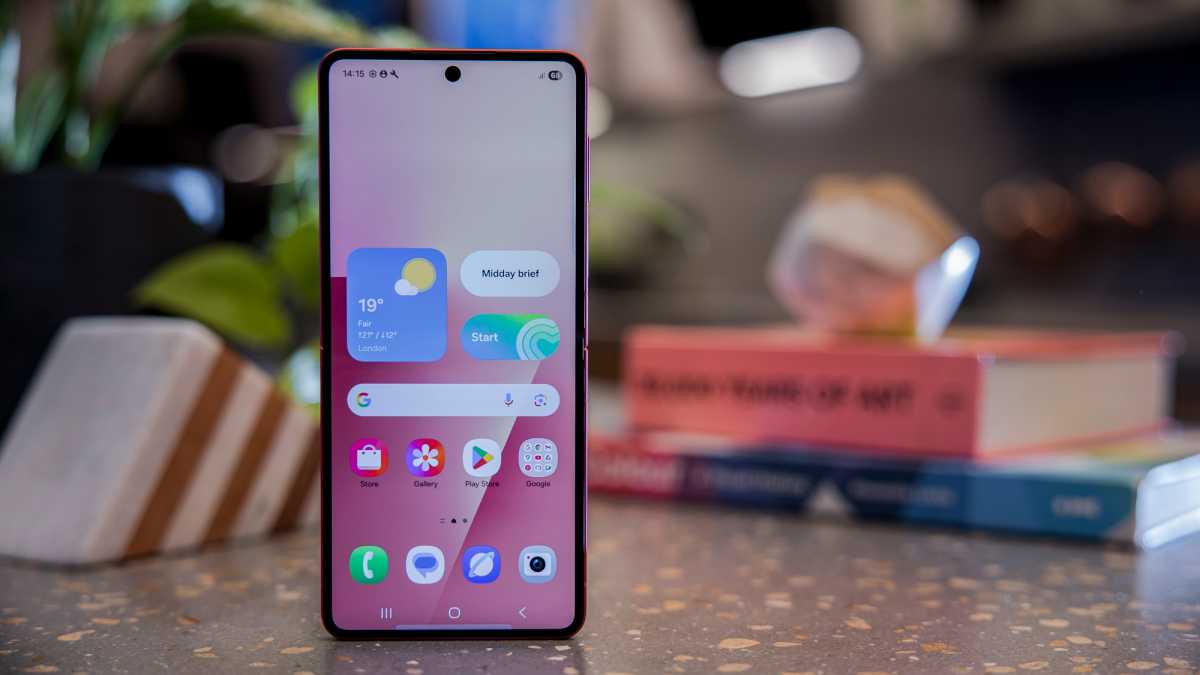
Dominik Tomaszewski / Foundry
For me, the latter is a negative – almost every Google app has a Samsung version, leading to a cluttered and potentially confusing user experience. Frustratingly, some of these Samsung apps can’t be uninstalled, making them annoying bloatware.
However, from a pure design perspective, I still prefer One UI aesthetic to the Pixel one. Samsung’s widgets are gorgeous, its quick settings panel is more intuitive, and the powerful AI-enhanced search is a game-changer.
The Samsung software experience remains one of the best in the business, including its long commitment to updates
Talking of AI, the suite of artificial intelligence here is almost identical to what you’ll find on the Galaxy S25 series. The only additions of note are automatic detections of people and audio in the background of photos, videos and voice recordings, which make it even easier to remove.
Galaxy AI offers a comprehensive suite of writing, translation, summarising and generative AI tools, many of which are useful, fun, or both. However, I still find Circle to Search and the Gemini virtual assistant to be the most useful.
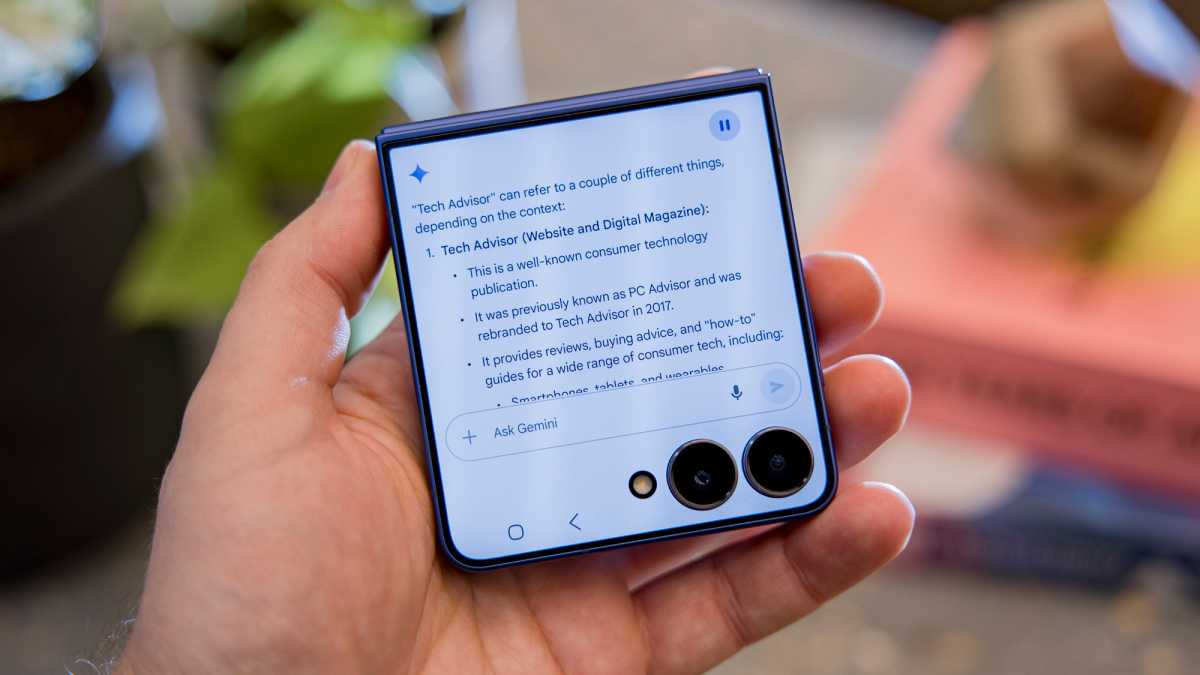
Dominik Tomaszewski / Foundry
Samsung has added Gemini support to the cover screen for the first time, allowing you to easily trigger it via the usual long press of the power button. It works well, and seems to just as accurate at recognising what I’m saying.
Another new cover screen feature is ‘Now Brief’, which was introduced on the Galaxy S25 series as a way to summarise key, personalised information throughout the day. It can draw on a variety of different sources, including your calendar, gallery, health data and news, but unless you own Samsung smart home or wearable devices, I don’t think it’s particularly useful.
And, as I mentioned in my Z Flip 7 live blog, the empty platitudes in the introductions really annoy me. What does “clouds in the sky give today a tranquil vibe” even mean?
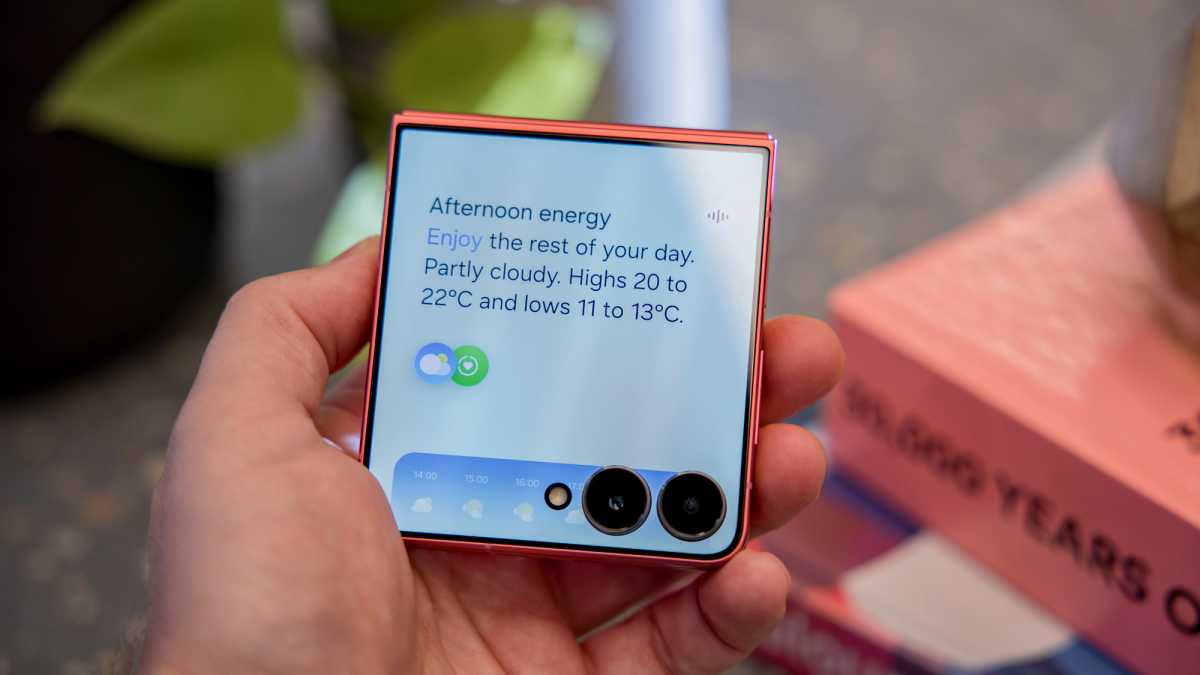
Dominik Tomaszewski / Foundry
Then there’s the frankly ridiculous process for getting any app running on the cover screen: Install the ‘Good Lock’ app from the Galaxy Store. Open it, then install and open ‘MultiStar’. Tap it, then ‘I ♡ Galaxy Foldable’, enable the ‘Launcher Widget’ and tap any apps you want to add to the cover screen. Finally, go to Settings and add the Good Lock widget to access them.
As frustrating as this is, the experience once you get it set up is surprisingly good. Despite none of these apps seemingly being optimised for the smaller screen, everything I tried worked without issue.
Despite some of the shortcomings mentioned, Samsung’s software experience remains one of the best in the business, including its long commitment to updates.
The Galaxy Z Flip 7 will receive seven years of major OS updates and seven years of security patches, which would make it safe to use until 2032. That remains the joint-best you’ll see on any phone, and a key reason to buy it over the Razr 60 Ultra (three years’ OS, four years’ security).
Price & Availability
At launch, the Galaxy Z Flip 7 starts at £1,049/$1,099.
That’ll get you the 256GB model I tested, though you can double it to 512GB for £1,149/$1,219.
You can buy one outright from a variety of retailers, including Samsung and Amazon in the UK or Samsung and Amazon in the US. The phone is also available on contract from a range of different networks in the UK and US.
With no price rise this time, the Z Flip 7 is now cheaper than its main rival in the Razr 60 Ultra/Razr Ultra 2025 (from £1,099/$1,299), which may be a dealbreaker for some, especially if you’re in the US, where the difference is greater. That wasn’t the case with the last generation, with the Z Flip 6 priced higher than its closest Motorola rival.
I do wonder whether the decision to omit that all-important telephoto lens helped to undercut Motorola this time around. Admittedly, Samsung’s current price isn’t under the £1,000/$1,000 mark that the 50 Ultra was back in 2024, so value for money isn’t quite as impressive – though inflation must also be taken into account.
If you don’t need a flip phone, plenty of the best phones you can buy are more affordable.
Should you buy the Samsung Galaxy Z Flip 7?
If you’re in the market for a flip phone and willing to pay the premium, yes. Despite a few key faults, the Z Flip 7 is my top recommended Flip phone right now.
Why? The blend of a sleek, premium design, excellent displays, a great main camera and a top-tier software experience makes it hard to beat. A full seven years of updates is the icing on the cake.
However, the combination of mediocre battery life and slow charging could be a dealbreaker for some people, while the lack of a telephoto camera can be problematic at times.
This smartphone series hasn’t received a price hike this year, as Motorola’s did, making it an even better value proposition. However, the fact that the same frustrations from the Z Flip 6 persist stops it from getting an even higher score.
Nonetheless, if you’re looking for a flip phone that will serve you well now and into the future, the Galaxy Z Flip 7 is the device for you.
Specs
- 4.1-inch, 120Hz AMOLED cover display
- 6.9-inch, 120Hz LTPO AMOLED main display
- Samsung Exynos 2500
- 12GB RAM
- 256/512GB storage
- 50Mp, f/1.8 main camera
- 12Mp, f/2.2 ultrawide camera
- 10Mp, f/2.2 selfie camera
- 4300mAh battery
- 25W wired charging
- 15W wireless charging
- 4.5W reverse wireless charging
- Stereo speakers
- IP48 water and dust resistance
- Gorilla Glass Victus 2 back
- Wi-Fi 7
- Bluetooth 5.4
- 166.7 x 75.2 x 6.5 mm (open), 85.5 x 75.2 x 13.7 mm (closed)
- 188g
- One UI 8 over Android 16


